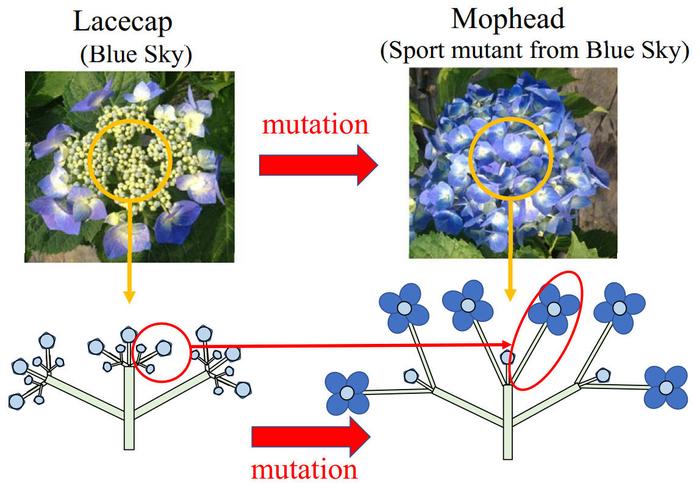China
October 17, 2025

Changes in inflorescence structure associated with mutation from the lacecap phenotype to the mophead phenotype. - Credit: Horticulture Research
The secret to tomato size lies within the flower's core. Scientists have discovered that the gene SlKNUCKLES (SlKNU), which encodes a zinc finger protein, serves as a key switch that determines fruit size by regulating floral meristem activity—the tissue responsible for forming reproductive organs. Using CRISPR/Cas9 gene editing, researchers found that SlKNU represses two stem cell genes, SlWUS and SlCLV3, to control how long the meristem stays active. When SlKNU was disabled, the meristem expanded and fruits grew larger with more locules. This study provides a genetic explanation for how plants balance flower formation and fruit yield, opening possibilities for precision crop breeding.
Floral meristems (FMs) are plant growth centers that orchestrate the formation of flowers and ultimately define fruit size. Their activity must stop at just the right time—too soon, and flowers fail to develop properly; too late, and fruits become oversized or misshapen. In the model plant Arabidopsis, the CLV3–WUS feedback loop and the KNUCKLES (KNU) gene maintain this delicate equilibrium. Tomatoes, however, have a more complex flowering pattern, and how their KNU counterpart regulates meristem termination has remained unclear. Due to these gaps in knowledge, scientists sought to uncover how the tomato homolog SlKNU precisely coordinates floral meristem determinacy and fruit size.
A research team from Nanjing University and Huaiyin Normal University has uncovered how a single gene shapes tomato fruit size. The study (DOI: 10.1093/hr/uhae332), published on March 1, 2025, in Horticulture Research, reveals that the zinc finger protein SlKNU directly shuts down key stem cell genes—SlWUS and SlCLV3—to halt floral meristem growth at the right moment. Through advanced genetic and molecular approaches, the team showed that SlKNU functions as a molecular brake, ensuring flowers mature correctly and fruits reach optimal size, offering new insights into yield control in Solanum lycopersicum.
Using CRISPR/Cas9 gene editing, the researchers generated SlKNU knockout mutants, named CR-slknu-15 and CR-slknu-17. These plants exhibited enlarged floral meristems, an increased number of floral organs, and fruits with significantly more carpels and locules than wild-type plants, resulting in visibly larger tomatoes. Microscopic analysis confirmed that the floral meristem diameter in mutants was much wider, linking SlKNU loss to enhanced stem cell activity. Conversely, plants overexpressing SlKNU showed stunted growth and reduced meristem vigor, yet still formed normal carpels, suggesting a precise regulatory role rather than developmental inhibition.Molecular assays revealed the mechanism behind this effect. Dual-luciferase, EMSA, and yeast one-hybrid tests confirmed that SlKNU directly binds to the promoter regions of SlCLV3 and SlCLV1, repressing their transcription. Its EAR repression domain proved essential for this function. Remarkably, introducing SlKNU into Arabidopsis knu-2 mutants completely restored their normal flower development, highlighting a conserved evolutionary role across plant species. Together, the results establish SlKNU as a pivotal regulator linking meristem determinacy to fruit formation.
“Our study reveals how SlKNU acts like a conductor in the orchestra of flower development, directing when stem cells should stop dividing to define the final fruit size,” said Professor Bo Sun, corresponding author of the study. “By directly repressing SlWUS, SlCLV3, and SlCLV1, SlKNU ensures that floral meristem activity ends at the right time. Understanding this genetic control offers powerful opportunities for improving fruit yield and quality not only in tomato but also in other economically important crops.”
The discovery of SlKNU's regulatory role opens new avenues for precision agriculture. By fine-tuning SlKNU expression, breeders could tailor fruit size and yield with unprecedented accuracy while maintaining normal flower development. This gene's functional conservation across species also suggests its potential use in other fruit-bearing crops such as peppers and eggplants. Combining SlKNU-based genetic strategies with CRISPR technology could accelerate the development of high-yield, high-quality varieties, contributing to global efforts in sustainable food production and smarter crop engineering.
References
DOI: 10.1093/hr/uhae332
Original Source URL: https://doi.org/10.1093/hr/uhae332
Funding information
This study was partially supported by the Japan Society for the Promotion of Science and Grants-in-Aid for Scientific Research, KAKENHI (grant numbers: JP18K14461, JP18K05628, 22H05172, 22H05181, and 24580049).
About Horticulture Research
Horticulture Research is an open access journal of Nanjing Agricultural University and ranked number one in the Horticulture category of the Journal Citation Reports ™ from Clarivate, 2023. The journal is committed to publishing original research articles, reviews, perspectives, comments, correspondence articles and letters to the editor related to all major horticultural plants and disciplines, including biotechnology, breeding, cellular and molecular biology, evolution, genetics, inter-species interactions, physiology, and the origination and domestication of crops.